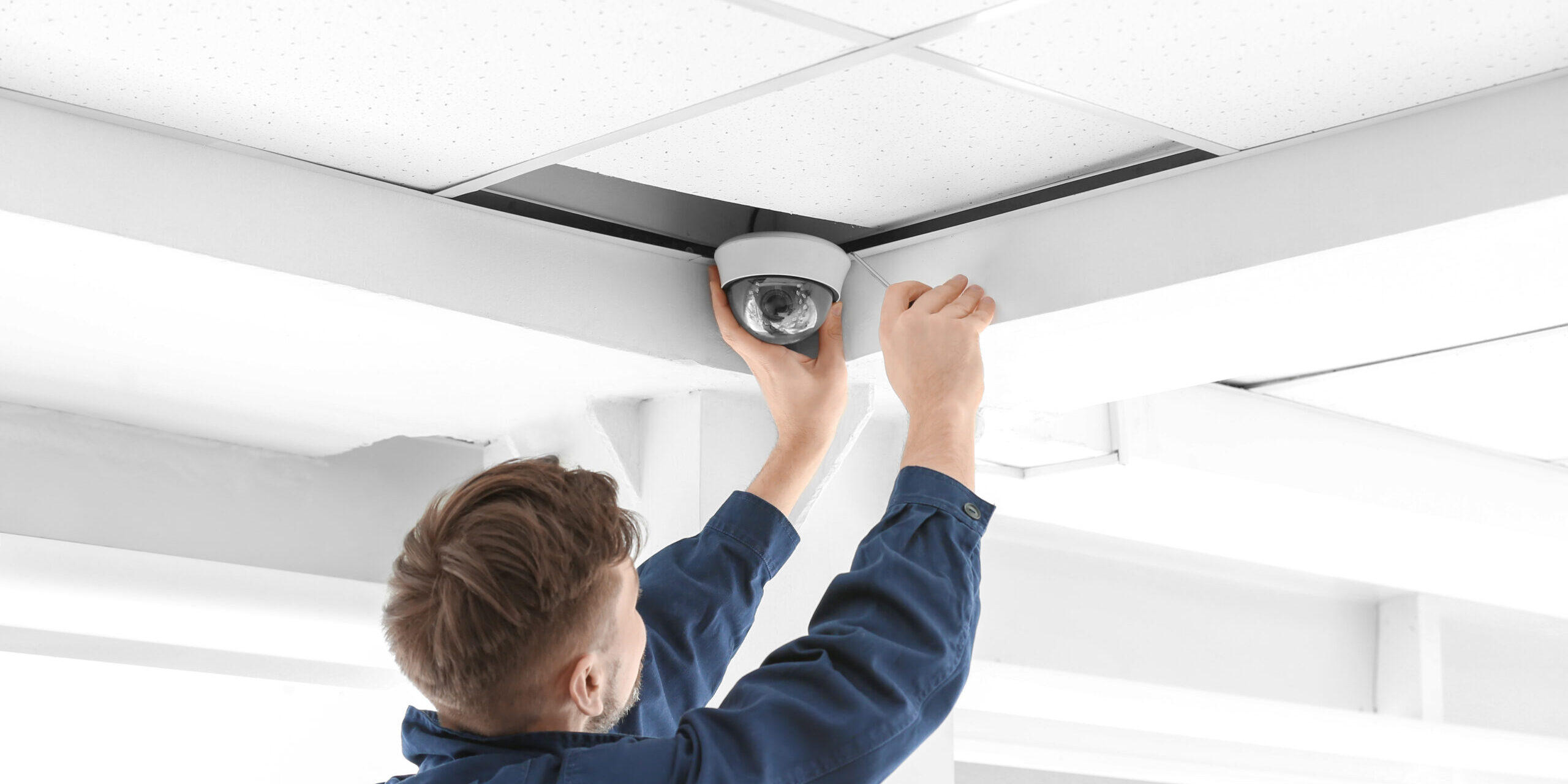Are you planning to build a new alarm system to safeguard your company’s assets? Would you like to arm and disarm the system from any location or receive alerts on your smartphone whenever the alarm trips?
How to Install a Home Security System
Hello and welcome to modern burglar alarm systems and commercial burglar alarm installation.
Commercial alarm systems are available in various designs, levels of integration, and applications. A DIY system using wireless motion detectors and glass break sensors will suffice for specific alarm systems that need to protect smaller companies. Other alarm systems need to safeguard sizable retail or office buildings. Also, their installation calls for careful consideration by a qualified security expert. Any firm that stores valuable goods or sensitive information needs a commercial-grade alarm system.
Why? When coupled with your video surveillance system, an alarm system may capture an attempted break-in and notify the police of any illegal activity at your location.
You might take various alternatives and routes regarding alarm installation, from do-it-yourself residential buildings to professionally installed and integrated commercial systems. When looking for high-level, comprehensive, and practical security measures, a system installed by commercial alarm companies and professional security installers is the way to go. While a quick, easy DIY alarm system may be acceptable for monitoring your front door on a tight budget, it is not recommended.
Why Go for Professionals to Install Your Home Security System
The following are some justifications for why firms ought to think about employing security system providers to install your home alarms:
It’s Easier
Even though a straightforward DIY installation may seem simpler than integrating a complete system, mainly if it’s only for your house or small business, it’s frequently even simpler to hand things off to the specialists and let them do something. Local alarm firms, certified system integrators, and installers are skilled and qualified experts who can design, price, incorporate, and install specialized home security systems to meet your precise requirements. Alarm system providers can do the task for you since they are trained. This freezes your time to focus on other vital activities like managing your business or spending time with your loved ones.
The installer carries out maintenance and upgrades.
Working with a qualified systems integrator will free you from these responsibilities and make your life easier because they can take care of all system maintenance, upgrades in the future, and repairs. They’ll be able to lead you toward the specific hardware and software changes your system requires to function correctly and stay current for many years to come.
When something goes wrong, seek help.
A systems integrator or an expert in alarm installation will often offer current, practical, and convenient tech support and help desk assistance anytime you run into issues and need assistance troubleshooting your system. You won’t ever feel alone or unprotected when something goes wrong because this help is sometimes available 24/7. And if the issue is one that a little tech help can’t handle, they’ll send a skilled and experienced expert to diagnose and get everything back up and running.
Modern Security Technologies
Systems integrators are knowledgeable about the most recent advancements in security technology, including ultra-high definition cameras with the most cutting-edge analytics algorithms and technology and sophisticated radar-detecting sensors for maximum security facilities. One complete system that can be readily upgraded, scaled, and expanded and offers the latest cutting-edge technology to keep your home and place of business secure for years to come may be created by efficiently integrating all these components and technologies.
Cheapest Prices For Security Components
Systems integrators and installers may frequently offer excellent pricing and discounts on the newest technology and security components because they are distributors. This is especially true when buying and installing a complete system. They often combine the equipment and installation into one tidy, simple package.
It possibly Even Contain Monitoring.
The same commercial alarm companies that installed your system will also monitor and maintain it. It enables you to have a worry-free, hassle-free security experience. Alarm monitoring is not always included or offered by the alarm installation specialist. However, it frequently provides a convenient, comprehensive installation and monitoring package. Integrators and installers who don’t monitor will nearly always work with a monitoring firm that they are familiar with and confident in. This monitoring company will be able to link you to monitoring during the installation process.

The Best Practices to Install Home Security System
These are covered in a more thorough post that we have available.
Alarm Takeovers: Features and Advantages
An alarm takeover is one of the most excellent upgrade methods; don’t worry. It’s a quick and painless procedure. The alarm system is modified with a more contemporary keypad, utilizing the original wiring. You may benefit from the most recent alarm technology and features without completely replacing your alarm system. Additionally, it costs less than installing a brand-new design.
An Introduction to Hardwired Security Systems
Your hardwired home security system consists of a professionally installed, pre-installed set of sensors and monitors. Contrary to common misconception, cutting any wire (or even the red one) won’t deactivate a hardwired system. On the contrary, doing so would just set off the alarm. Apart from the initial installation, no batteries need to be changed frequently, and the system is inexpensive.
Upgrading With A Takeover Of The Alarm
An alarm system takeover is a relatively straightforward process. Only the broken components are replaced in the repair of the sensors and wiring. The old metal box where your control panel is located and the dingy old keypad on the wall is where the takeover’s action is concentrated. Your box’s obsolete panel is swapped out for one that matches the brand-new keypad, connecting your old sensors to the fresh interface. Your new keypad often communicates with your smartphone via cellular technology, enabling you to manage your alarm system using a straightforward app.
New Components
In addition to the fundamental characteristics of the original keypad, the new touchscreen keypad offers brand-new functionalities. You may program delays and timetables to turn on your security system automatically when you go to bed at night or leave for the day. Additionally, when you install it, you’ll be able to link your security system to your home automation system, such as Amazon Alexa or Google Home, so that you may control your lights and alarm system using voice commands.
Utilizing wireless
Providers of alarm systems can execute a hardwired to wireless alarm takeover, enabling you to upgrade your current system with wireless sensors or keypads. In a wireless takeover, local alarm firms use a wireless translator to relay signals from your door and window sensors to a wireless touchscreen keypad. While motion and smoke detectors will theoretically work with your new wireless panel, they risk blowing their fuse since they use too much power. Some sensors, however, cannot be translated securely. You don’t need a wireless system if you only need door and window sensors.
Various Alarm System Components
The most excellent enterprise security systems have a few key characteristics: they are intense, challenging to defeat, and tailored to the demands of the particular company. Burglar alarms exist in various sizes and styles, so you should create a unique system that suits your requirements. Whatever their configuration, commercial security systems must include the following components:
Admin Panel
There is a specific control panel for each type of burglar alarm system. Everything in the system is wired or wirelessly connected to the control panel, the system’s central processing unit.
Keypad
It is the system’s user interface. This pad is typically located close to the main entrance or at critical checkpoints. It allows you to activate and disarm the system and frequently facilitates two-way communication with your security system monitoring station.
Window And Door Contacts
These usually use magnetic sensors to link from the door to the jamb or from the window to the wall. The alarm is set off when the sensor contact is compromised, like when a door or window is opened.
Break glass detectors
Glass break detectors listen for the precise frequency of shattering glass. Even if the window contact sensor is disregarded, these sensors can still set off the alarm in the event of an intrusion.
Movement sensors
Passive infrared (PIR) technology, which primarily detects the redistribution of body heat, is used in most interior motion detectors. Bugs and spider webs do not trigger PIR movements, so they eliminate false alerts. Outdoor motion detectors employ passive infrared and microwave technologies to prevent false signals from squirrels and other tiny animals.
Sensors for System Interruptions
The top company burglar alarms will be equipped with fail-safes that guard against tampering. If any system component is taken offline, loses power, or fails to react to ping, an interruption sensor will send an alarm.
Smoke detectors
Both types of smoke detectors feature a power source, a detector, and an electronic horn or siren. The power source might be a battery or a cable that connects to another power source, usually the building’s. The horn is used to alert fire or indicate a low battery with piercing chirps or harsh sirens, as appropriate. The sort of burning object the alarm intends to detect determines the technique.
-
Smoke detectors with ionization
An element that is just slightly radioactive ionizes the air in an ionization smoke detector. The americium’s alpha particles charge air particles permitted to enter the ionization chamber. According to their new positive or negative charge, the charged air atoms flow between two charged plates, forming an electrical circuit.
Both an open section and a sealed control tube may perform this concurrently. The portion exposed to ambient air detects fires, while the control tube is used to establish a baseline. Ionized air binds to smoke particles entering the detector, breaking the circuit and sounding the alarm. Ionization detectors work better at seeing active fires than spotting smoldering fires.
-
Smoke detectors that work with light
On the other hand, photoelectric (or optical) sensors employ a beam of light to find changes in the air. Smoke is detected using light, which can be visible, infrared, or ultraviolet, and which scatters when smoke partially blocks the light. These optical detectors come in two different varieties. In the first, light is directed toward the sensor. In the second, an alarm activates when the received light drops below a certain threshold due to scattering. Also, in the second, more prevalent type, the sensor only detects light reflected from smoke and activates when the amount of reflected light exceeds a safe threshold.
However, despite some difficulties, photoelectric smoke detectors may also detect burning, quickly spreading flames. Photoelectric smoke detectors generally respond better to slow-starting, smoldering fires than ionization detectors. The best option for household and business safety systems is an optical smoke detector, which responds to smoke more quickly than ionization detectors.
Built-in Alarms
Smoke detectors in homes are typically standalone, battery-operated devices hung on the ceiling, but they can also be linked to your house’s electrical system. You may install or connect them wirelessly to your home burglar alarm or security system. If you integrate them, you can have more control over your alarm system and monitor them from your alarm keypad.

Motion Detector Operation
Motion detectors for security systems come in a few different varieties, but they may be divided into passive and active groups. Active systems emit and receive some signal to detect the existence of things, whereas passive systems only watch for changes.
-
Motion detectors with passive IR
The most frequently detected quick changes in the infrared spectrum are passive infrared, or PIR, sensors. PIR can detect infrared light, which is heat that is generated by people and things but is undetectable to the human eye. Fresnel lenses are typically used in PIR sensors to concentrate infrared light. A signal is transmitted when a quick change is detected throughout its field of view.
The sensor, however, is not activated by long shifts. Therefore, it is theoretically feasible to avoid them by moving very slowly. It is tough to trick a PIR since, in reality, it is impossible to identify this threshold instantly. Also, security motion detectors are seldom the sole device to fool. To trigger the security system, the PIR can be connected to a quiet alarm, floodlights, a siren, or a camera.
-
Active motion sensors
Although less prevalent, active motion detectors are nevertheless valuable for security. Some people employ an emitter that directs a light beam into a photosensitive sensor and across a room or corridor. If the beam is broken, the sensor emits a signal similar to a PIR. These are frequently seen as safety switches at the bottom of residential garage doors. The door stops moving when a person or item passes through the beam.
Other active sensors use reflected ultrasonic waves to monitor the environment. The alarm goes off, the camera starts recording, or another method of alerting you to a potential intruder is used when sonar detectors generate a sound wave and measure the duration and strength of their return. Radar is used similarly by another sensor. Pulses of radio frequency microwaves are transmitted, timed, and calculated upon return.
-
Motion detectors Using Security Cameras.
Today’s security cameras may also be employed as motion detectors through basic video analytics. Any signals can be sent out when the camera detects an item crossing, entering, or departing a virtual line or box indicated on the control panel. In addition to starting to record, the camera can switch on lights, sound an alarm or siren, or email you a notice. False alarms can be decreased or eliminated by using advanced analytics only to react when a human or vehicle enters the area. You can reduce the complexity of your security system by using your security cameras as motion detectors. However, your security system may be constrained if you don’t have independent motion sensors.
Although panic buttons come in various sizes and designs, they all have the same function: they let you promptly call the police. The police treat panic alarms as calls in progress, just like confirmed alarms. Because they are more likely to be false alarms, other alarms your burglar alarm sends out don’t have the same importance as an emergency alert.
-
Panic buttons with a hardwire
Typically, desk-mounted panic buttons connected to the building’s burglar alarm are used in banks and heavily trafficked workplaces. These quiet alarms are frequently deployed when potentially harmful individuals generate a disturbance. A volatile situation may have been rapidly resolved before it was reported. Thanks to a panic button on the wall over the receptionist’s desk.
-
Siren Or Silence?
Commercial panic buttons frequently link to silent alarms, as was already explained. However, there are times when you want a loud siren to scare off intruders. Because sirens could aggravate or incite armed thieves, banks often prefer their panic buttons to be silent. The same is valid for retail establishments and offices: violent outbursts in small places typically don’t turn out nicely. However, larger campuses with several exits could necessitate an audio alarm deployment. In the event of an issue, those in adjacent spaces will be informed and allowed to lock down or evacuate.
-
Cellular panic buttons
Other panic buttons are made to be worn as lanyards, necklaces, key chains, or even wristbands. They can serve the same functions as medical alert buttons because they are comparable. These personal panic buttons benefit huge businesses or other campuses where deadly situations might occur. An implanted panic button won’t be used if no one is around to press it.








